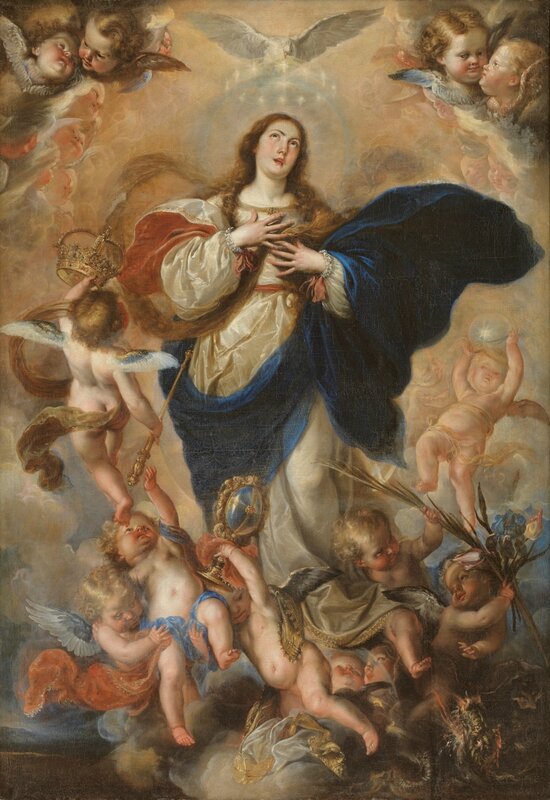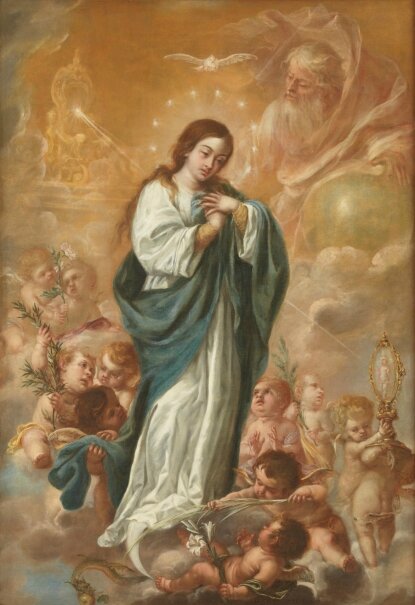Exhibition at Museo del Prado presents different depictions of a single subject: The Immaculate Conception
Francisco Zurbarán (1598-1664), The Immaculate Conception. Oil on canvas, 128 x 89 cm. Ca.1630. Madrid, Museo Nacional del Prado. Acquired in 1956.
MADRID.- Following the generation donation made last year by Plácido Arango, the Museo del Prado is organising a new special presentation which on this occasion brings together a group of works within the donation that all share the same subject-matter, that of the Immaculate Conception, one of the most frequently depicted themes among Spanish Golden Age artists, which they used to express changing ideals of female beauty.
Painted between 1630 and 1680, this specially selected group of works allows for an understanding of how the subject of the Immaculate Conception varied between two types: one that emphasised intimacy, reflection and concentration, and another that made use of Baroque formulas expressed in dynamic, colourful compositions. This display juxtaposes the earliest Immaculate Conception in the donation and the one already in the Prado’s collection, both by Zurbarán. A comparison between the two reveals the different iconographical and compositional options considered by the artist at the start of his career: in comparison to the formal concentration and emotional introspection of the version housed in the Prado since 1956, the work from the Arango Donation is a dynamic work notable for the Virgin’s billowing tunic.
Francisco Zurbarán (1598-1664), The Immaculate Conception. Oil on canvas, 101.2 x 77.3 cm. 1625 - 1630. Madrid, Museo Nacional del Prado.
The second Immaculate Conception by Zurbarán in the donation, dated 1656, forms a connecting link with the rich tradition of depictions of this subject in Seville in the second half of the 17th century and can be compared with the Immaculate Conception by one of the leading representatives of that school, Juan de Valdés Leal. In the latter work, dated 1682, the painter avoids his characteristic compositional dynamism and communicative power in order to offer a delicate, introspective work in which the young Mary is located in an elaborate theological setting.
Francisco Zurbarán (1598-1664), The Immaculate Conception. Oil on canvas, 194.3 x 157 cm. 1656. Madrid, Museo Nacional del Prado.
Another important focus of production for images on this subject was Madrid, represented here by the donation of an Immaculate Conception by Mateo Cerezo executed around 1660. Its dynamic style and wide chromatic range are traits that contributed to the evolution towards a fully Baroque style in Madrid painting. The exhibition also includes a new addition made by Plácido Arango to his initial donation. This is an Immaculate Conception by Francisco de Herrera the Younger, one of the key names in painting in Seville and Madrid in the mid-17th century although now only known through a relatively small oeuvre. This painting, which will be retained by its owner for his lifetime enjoyment, represents a significant contribution to the Museum’s holdings.
Mateo Cerezo (1637 - Madrid, 1666), Immaculate Conception. Oil on canvas, 211.5 x 147.5 cm. Ca. 1660. Madrid, Museo Nacional del Prado.
Francisco de Herrera the Younger (1627-1685), The Immaculate Conception. Oil on canvas, 165 x 105 cm. Ca. 1670.Donación Plácido Arango Arias, 2016. Madrid, Museo Nacional del Prado.
To coincide with this presentation, the Prado has published a book that offers individual entries on the 26 works in the donation in addition to a text that assess its importance as a whole within the context of the Museum’s collections. The Immaculate Conception by Francisco Herrera the Younger. A new addition to the Plácido Arango Donation
The addition of this Immaculate Conception by Francisco Herrera the Younger, the artist of one of the Prado’s great masterpieces (The Dream of Saint Joseph), represents an important contribution to the Museum’s collection, given that no other work by Herrera is known on this subject despite it being one of the most widely depicted by Spanish artists of his generation.
In his work Herrera offers an alternative to the iconographic models most commonly used for the subject in Spain in the second half of the 17th century, making use of a formal and emotional restraint unusual at the time but which is also present in some contemporary versions such as the canvas by Valdés Leal also included in this donation.
Particularly notable is the chromatic precision based on the combination of the ivory tones of the Virgin’s tunic and the dark blue of her mantle, as well as the interest in detail and the carefully devised composition.
Juan de Valdés Leal (1662-1690), Immaculate Conception. Oil on canvas, 206.5 x 144 cm. 1682. Madrid, Museo Nacional del Prado.

/https%3A%2F%2Fprofilepics.canalblog.com%2Fprofilepics%2F1%2F0%2F100183.jpg)
/https%3A%2F%2Fstorage.canalblog.com%2F03%2F02%2F119589%2F96711876_o.jpg)
/https%3A%2F%2Fstorage.canalblog.com%2F11%2F31%2F119589%2F94773502_o.jpg)
/https%3A%2F%2Fstorage.canalblog.com%2F20%2F83%2F119589%2F94772815_o.jpg)
/https%3A%2F%2Fstorage.canalblog.com%2F26%2F72%2F119589%2F75604929_o.jpg)
/https%3A%2F%2Fstorage.canalblog.com%2F59%2F60%2F119589%2F26458628_o.jpg)








/http%3A%2F%2Fstorage.canalblog.com%2F00%2F76%2F577050%2F38716989_p.jpg)
/http%3A%2F%2Fstorage.canalblog.com%2F71%2F68%2F119589%2F96420526_o.jpg)
/image%2F1371349%2F20240425%2Fob_c453b7_439605604-1657274835042529-47869416345.jpg)
/image%2F1371349%2F20240425%2Fob_59c6f0_440358655-1657722021664477-71089985267.jpg)